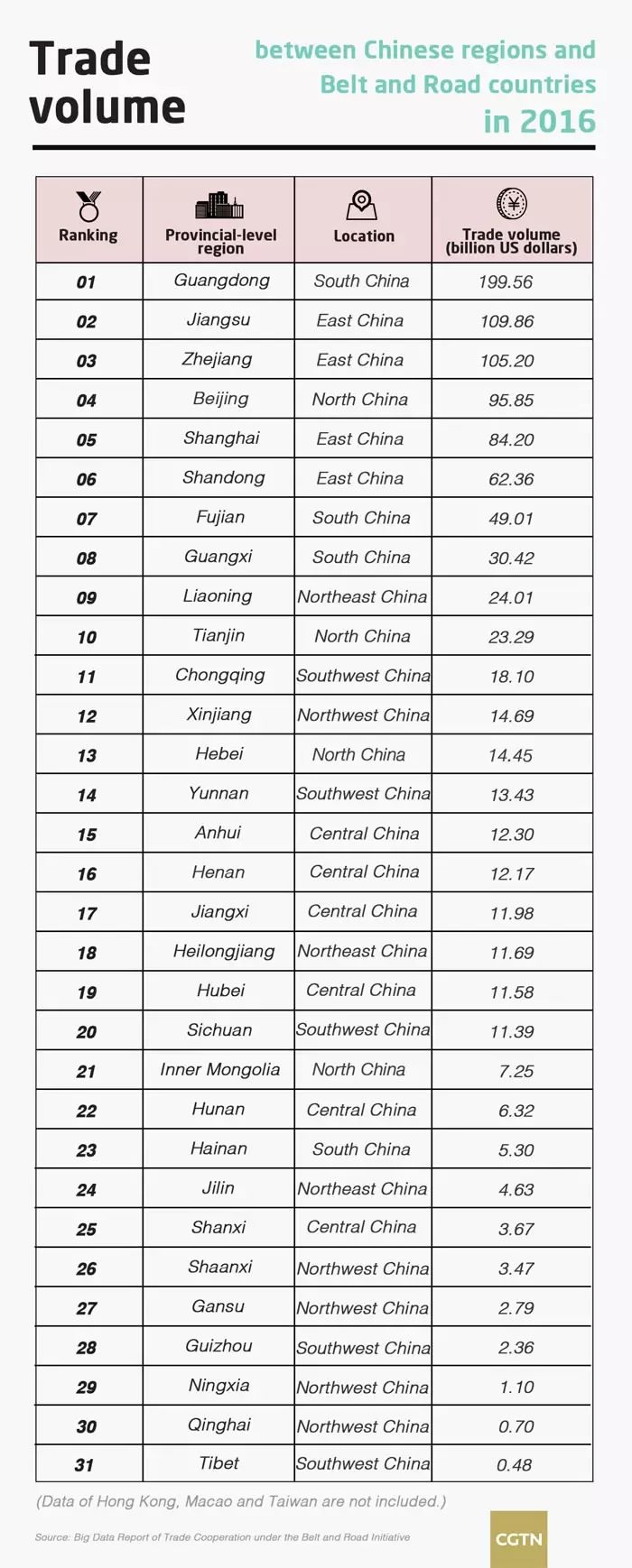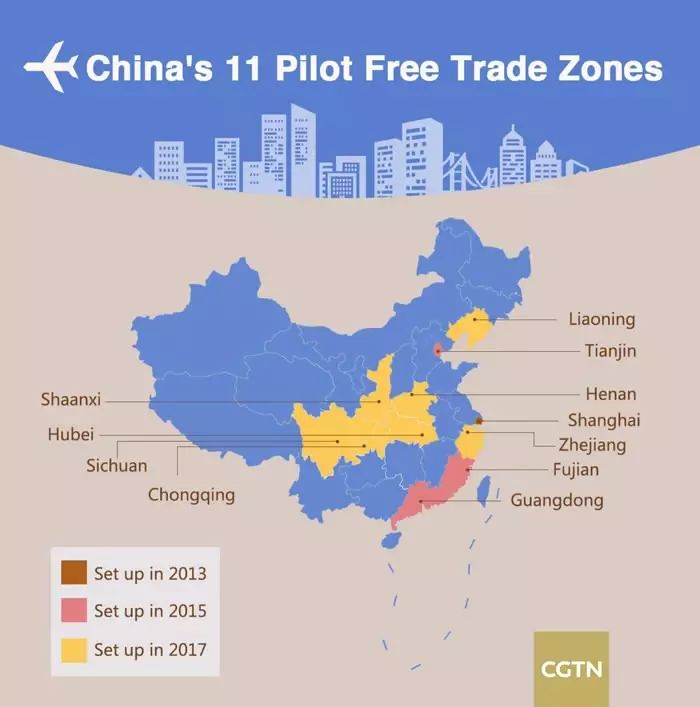Big Data: B&R Initiative boosts China's nationwide opening up
Posted CGTN
tags:
篇首语:本文由小常识网(cha138.com)小编为大家整理,主要介绍了Big Data: B&R Initiative boosts China's nationwide opening up相关的知识,希望对你有一定的参考价值。
随着起步于东南沿海的对外开放政策向广袤的中西部地区延伸,中国正逐步进入“开放2.0”时代——举国开放、共同开放的时代。
2015年3月28日,中国发布了“一带一路”倡议的行动方案,把沿海、内陆和边疆地区放在同等重要的位置,平衡区域发展、促进举国开放的意图非常明显。
然而,全国范围内的共同开放绝非一日之功。最新数据显示,就与“一带一路”沿线国家的贸易额而言,华东和华南地区仍然强势领跑,内陆和边疆地区的追赶之路注定充满艰辛——就看它们能否利用好“一带一路”倡议带来的重大机遇了。
Two years ago, China unveiled an action plan for the Belt and Road Initiative, placing equal emphasis on its coastal, inland and border regions in a bid to promote balanced development in an era of accelerated nationwide opening up.
However, latest figures show that traditional economic powerhouses in the eastern and southern parts of the country still play a dominant role in trade volume with countries along the Belt and Road. Meanwhile, the vast inland and border areas are still lagging behind it, as the potentials offered by the ambitious development framework are yet to be fully unlocked.
地区鸿沟
过去两年,虽然全国各个地区均积极参与“一带一路”倡议,但贸易数据上的鸿沟依然巨大。国家信息中心“一带一路”大数据中心等机构共同编写的《“一带一路”贸易合作大数据报告(2017)》显示,2016年华东、华南两个地区与沿线国家的贸易额超过全国贸易总额的三分之二。在排名前10的省份中,有9个位于沿海地区,唯一的例外还是首都北京。
Wide regional gaps
Since 2014, regions across China have been deeply involved in taking part in the Belt and Road Initiative, however, not equally.
According to a recently released report, China's total trade volume with the Belt and Road countries climbed to 953.59 billion US dollars in 2016, of which 587.48 billion US dollars came from exports.
The Big Data Report of Trade Cooperation under the Belt and Road Initiative was jointly compiled by the Belt and Road Big Data Center of China's State Information Center, Dalian Northeast Asia Big Data Center and other big data companies.
In terms of trade volume by region, gaps between China's coastal, inland and border areas showed little sign of narrowing. Last year, trade volume of the eastern and southern parts of China accounted for more than two thirds of the country's total trade value with Belt and Road countries.

The share of east China – Zhejiang, Jiangsu and Shandong provinces and Shanghai Municipality – expanded from 34.1 percent in 2014 to 37.9 percent in 2016 and that of south China – Guangdong, Fujian and Hainan provinces and Guangxi Zhuang Autonomous Region – grew from 25.7 percent to 29.8 percent.
By contrast, the portion of north China decreased sharply from 19.0 percent to 14.8 percent and that of the southwestern, northeastern and northwestern regions dropped moderately to 4.8, 4.2 and 2.4 percent respectively.
The trade volume of central China accounted for 6.1 percent last year, up 0.5 percentage points from 2014.
Guangdong topped all 31 provincial-level regions on the Chinese mainland, accounting for 20.9 percent of the nation's trade volume with the Belt and Road countries. It was followed by Jiangsu, Zhejiang, Beijing, Shanghai, Shandong, Fujian, Guangxi, Liaoning and Tianjin, all of which are located along the coastal line except the Chinese capital.
At 199.56 billion US dollars, Guangdong's trade volume was more than 13 times that of Xinjiang Uygur Autonomous Region – a pivotal region along the Silk Road Economic Belt.

政策利好
尽管一时还难与沿海地区争雄,但政策的支持是中西部地区奋起直追的底气。
在官方公布的《推动共建丝绸之路经济带和21世纪海上丝绸之路的愿景与行动》中,西北、东北、西南、沿海及内陆地区均被赋予重任,大多数省份的角色被明确提及。其中,西北的新疆和东南的福建分别被确定为“一带”和“一路”的核心区;在沿海港口继续获得支持的同时,郑州、武汉、重庆和成都等中西部重镇也将被建设成推动内陆和西部开放的支点城市。
Balanced blueprint for balanced development
The leading positions of east and south China in trade are the natural result of early favorable schemes, as the regions have benefitted from the reform and opening up policy that kicked off in the late 1970s. But the time has come for other regions to play bigger roles under the Belt and Road Initiative.
The action plan, called Vision and Actions on Jointly Building Belt and Road, covers all major regions of the country, including the northwestern, northeastern, southwestern, coastal and inland regions, and involves most of the provinces, autonomous regions and municipalities as well as Hong Kong, Macao and Taiwan.
It was jointly issued by the National Development and Reform Commission, the Ministry of Foreign Affairs and the Ministry of Commerce on March 28, 2015.

Xinjiang, in northwest China, will be made a core area on the Silk Road Economic Belt, with its role underscored as a window of westward opening up to deepen communication and cooperation with Central, South and West Asian countries. Meanwhile, coastal Fujian Province will be supported in becoming a central point of the 21st-Century Maritime Silk Road.
Aside from conferring primordial importance to domestic areas along the Belt and Road, the blueprint also singles out major ports, airports, land ports and cities as hubs along the routes, which, by and large, are evenly distributed between coastal and inland regions.
Zhao Kejin, associate professor at the Institute of International Studies at Tsinghua University in Beijing, believes key inland hubs such as Zhengzhou, Wuhan, Xi'an, Chongqing and Chengdu in the central and western regions have significant roles to play.
In an article published on China.com.cn, he stressed that these cities should lead inland regions in pursuing opening up to the outside world and take the initiative to cooperate with coastal and border regions as well as countries along the Belt and Road.

自贸区的西进
对追赶者来说,好消息不止“一带一路”倡议本身,还有与之密切相关的另一项重大举措——被李克强总理称作“扩大开放的破冰船、深化改革的挖掘机”的自贸区的落地。
2017年4月1日,中国第三批自贸区正式挂牌。在辽宁、浙江、河南、湖北、四川、陕西、重庆这7个新的自贸区当中,除了位于东部的浙江和东北的辽宁,剩下5个都不临海。
继前两批自贸区落户上海、天津、福建和广东之后,新增的自贸区有望在引领中西部开放、推动全国均衡发展方面发挥关键作用。
Westward expansion of free trade zones
In April 2017, landlocked regions in China received a much-needed shot in the arm.
With several new pilot free trade zones launched in landlocked regions, the world's second largest economy is speeding up efforts to carry out of the Belt and Road Initiative and rebalance regional development.
Two zones were established in coastal provinces of Zhejiang and Liaoning, and another five zones were set up in traditionally less open regions, namely Henan and Hubei provinces in central China, Chongqing Municipality and Sichuan Province in southwest China as well as in the northwestern province of Shaanxi.
The seven zones are the third batch of free trade zones in China, after the establishment of ones in Shanghai in 2013 and Tianjin, Fujian and Guangdong in 2015 – all in coastal municipalities and provinces.

Described by Chinese Premier Li Keqiang as "icebreakers for expanding opening up" and "excavators for deepening reform," free trade zones carry strategic importance in cutting bureaucratic red tape and exploring financial innovation.
"The plan for free trade zones reflects China's will to build an open economy as a whole, but before doing that, it has to experiment with free trade zones in different parts of the country," Lu Shanbing, deputy director of the Silk Road Research Institute of Northwest University, told Xinhua news agency.
"The free trade zones will not prioritize a certain area, instead, they will help coordinate development between the mid-west and the east and close the gaps," he added.
By pioneering reform and opening up in China's central and western areas, the newly launched free trade zones have great potential to rebalance trade along the Belt and Road and ensure equitable regional development in the country.
以上是关于Big Data: B&R Initiative boosts China's nationwide opening up的主要内容,如果未能解决你的问题,请参考以下文章
r CodeRdéveloppépourle DU Analyste Big Data
HDU 1171 Big Event in HDU(01背包)